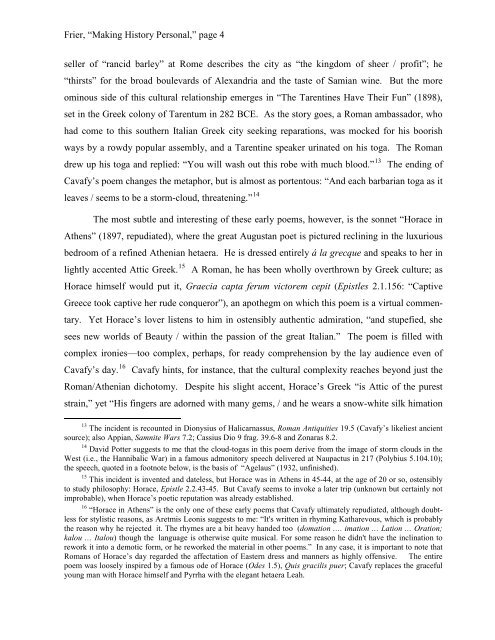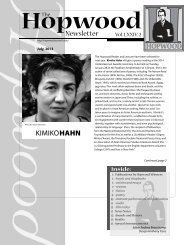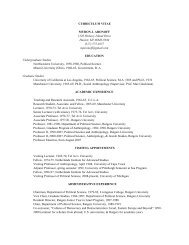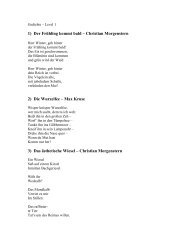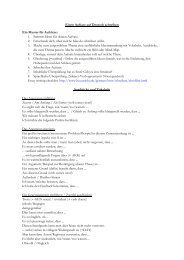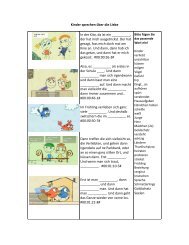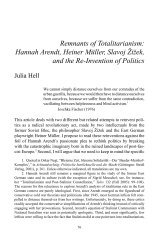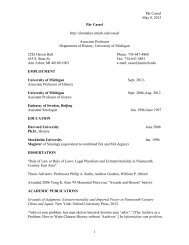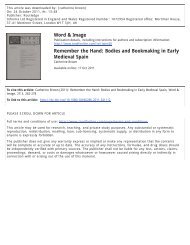Making History Personal: Constantine Cavafy and the Rise of Rome
Making History Personal: Constantine Cavafy and the Rise of Rome
Making History Personal: Constantine Cavafy and the Rise of Rome
Create successful ePaper yourself
Turn your PDF publications into a flip-book with our unique Google optimized e-Paper software.
Frier, “<strong>Making</strong> <strong>History</strong> <strong>Personal</strong>,” page 4<br />
seller <strong>of</strong> “rancid barley” at <strong>Rome</strong> describes <strong>the</strong> city as “<strong>the</strong> kingdom <strong>of</strong> sheer / pr<strong>of</strong>it”; he<br />
“thirsts” for <strong>the</strong> broad boulevards <strong>of</strong> Alex<strong>and</strong>ria <strong>and</strong> <strong>the</strong> taste <strong>of</strong> Samian wine. But <strong>the</strong> more<br />
ominous side <strong>of</strong> this cultural relationship emerges in “The Tarentines Have Their Fun” (1898),<br />
set in <strong>the</strong> Greek colony <strong>of</strong> Tarentum in 282 BCE. As <strong>the</strong> story goes, a Roman ambassador, who<br />
had come to this sou<strong>the</strong>rn Italian Greek city seeking reparations, was mocked for his boorish<br />
ways by a rowdy popular assembly, <strong>and</strong> a Tarentine speaker urinated on his toga. The Roman<br />
drew up his toga <strong>and</strong> replied: “You will wash out this robe with much blood.” 13 The ending <strong>of</strong><br />
<strong>Cavafy</strong>’s poem changes <strong>the</strong> metaphor, but is almost as portentous: “And each barbarian toga as it<br />
leaves / seems to be a storm-cloud, threatening.” 14<br />
The most subtle <strong>and</strong> interesting <strong>of</strong> <strong>the</strong>se early poems, however, is <strong>the</strong> sonnet “Horace in<br />
A<strong>the</strong>ns” (1897, repudiated), where <strong>the</strong> great Augustan poet is pictured reclining in <strong>the</strong> luxurious<br />
bedroom <strong>of</strong> a refined A<strong>the</strong>nian hetaera. He is dressed entirely á la grecque <strong>and</strong> speaks to her in<br />
15<br />
lightly accented Attic Greek. A Roman, he has been wholly overthrown by Greek culture; as<br />
Horace himself would put it, Graecia capta ferum victorem cepit (Epistles 2.1.156: “Captive<br />
Greece took captive her rude conqueror”), an apo<strong>the</strong>gm on which this poem is a virtual commen-<br />
tary. Yet Horace’s lover listens to him in ostensibly au<strong>the</strong>ntic admiration, “<strong>and</strong> stupefied, she<br />
sees new worlds <strong>of</strong> Beauty / within <strong>the</strong> passion <strong>of</strong> <strong>the</strong> great Italian.” The poem is filled with<br />
complex ironies—too complex, perhaps, for ready comprehension by <strong>the</strong> lay audience even <strong>of</strong><br />
<strong>Cavafy</strong>’s day. 16<br />
<strong>Cavafy</strong> hints, for instance, that <strong>the</strong> cultural complexity reaches beyond just <strong>the</strong><br />
Roman/A<strong>the</strong>nian dichotomy. Despite his slight accent, Horace’s Greek “is Attic <strong>of</strong> <strong>the</strong> purest<br />
strain,” yet “His fingers are adorned with many gems, / <strong>and</strong> he wears a snow-white silk himation<br />
13<br />
The incident is recounted in Dionysius <strong>of</strong> Halicarnassus, Roman Antiquities 19.5 (<strong>Cavafy</strong>’s likeliest ancient<br />
source); also Appian, Samnite Wars 7.2; Cassius Dio 9 frag. 39.6-8 <strong>and</strong> Zonaras 8.2.<br />
14<br />
David Potter suggests to me that <strong>the</strong> cloud-togas in this poem derive from <strong>the</strong> image <strong>of</strong> storm clouds in <strong>the</strong><br />
West (i.e., <strong>the</strong> Hannibalic War) in a famous admonitory speech delivered at Naupactus in 217 (Polybius 5.104.10);<br />
<strong>the</strong> speech, quoted in a footnote below, is <strong>the</strong> basis <strong>of</strong> “Agelaus” (1932, unfinished).<br />
15<br />
This incident is invented <strong>and</strong> dateless, but Horace was in A<strong>the</strong>ns in 45-44, at <strong>the</strong> age <strong>of</strong> 20 or so, ostensibly<br />
to study philosophy: Horace, Epistle 2.2.43-45. But <strong>Cavafy</strong> seems to invoke a later trip (unknown but certainly not<br />
improbable), when Horace’s poetic reputation was already established.<br />
16<br />
“Horace in A<strong>the</strong>ns” is <strong>the</strong> only one <strong>of</strong> <strong>the</strong>se early poems that <strong>Cavafy</strong> ultimately repudiated, although doubtless<br />
for stylistic reasons, as Aretmis Leonis suggests to me: “It's written in rhyming Katharevous, which is probably<br />
<strong>the</strong> reason why he rejected it. The rhymes are a bit heavy h<strong>and</strong>ed too (domation …. imation … Lation … Oration;<br />
kalou … Italou) though <strong>the</strong> language is o<strong>the</strong>rwise quite musical. For some reason he didn't have <strong>the</strong> inclination to<br />
rework it into a demotic form, or he reworked <strong>the</strong> material in o<strong>the</strong>r poems.” In any case, it is important to note that<br />
Romans <strong>of</strong> Horace’s day regarded <strong>the</strong> affectation <strong>of</strong> Eastern dress <strong>and</strong> manners as highly <strong>of</strong>fensive. The entire<br />
poem was loosely inspired by a famous ode <strong>of</strong> Horace (Odes 1.5), Quis gracilis puer; <strong>Cavafy</strong> replaces <strong>the</strong> graceful<br />
young man with Horace himself <strong>and</strong> Pyrrha with <strong>the</strong> elegant hetaera Leah.


